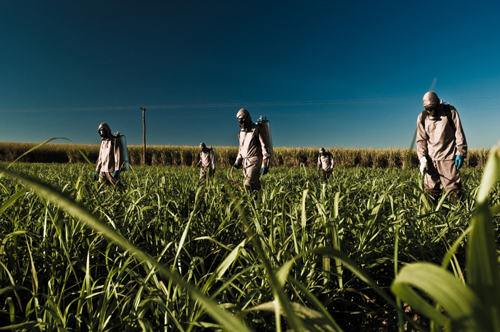
(Photo credit: iStockPhoto)
Brazil is now the fifth-largest producer of biodiesel in the world and the success of its Biodiesel Production and Use Program (PNPB) now poses new challenges and opportunities for producers and policymakers. An initiative by former President Luis Inácio Lula da Silva's government (2003-2010), the programme promotes energy security for sustainable rural development, incorporating both agribusiness and family farmers.
Since its adoption in 2005, national production has nearly tripled and Brazil is poised to overtake France, Germany, Argentina and the US if the blend ratio policy increases from 5 to 10 percent (Table 1). The question is whether Brazilian policymakers can agree to make the B10 blend the next big bet before the Earth Summit 2012 in Rio de Janeiro.
Table 1: Biodiesel production in five leading countries and the world, 2010
| Country |
Production in millions of gallons*
|
|
United States
|
750
|
|
Argentina
|
690
|
|
Germany
|
660
|
|
France
|
630
|
|
Brazil
|
510
|
|
World total
|
5,253
|
Betting on biodiesel
Brazil has been experimenting with vegetable oils as fuels since the 1920s. In the 1950s, several research institutes began testing ouricuri oil, castor bean oil, and cottonseed oil as possible biomass alternatives. However, it was not until the 1970s that policymakers focused on the production of biodiesel as an important substitute to lessen dependence on petroleum and its derivatives.
However, the drop in world oil prices in the mid-1980s prompted the government to abandon its biodiesel policies and programmes. This initial experience demonstrated Brazil's interest and possible comparative advantages in biodiesel production, and showed that an import substitution strategy would not overcome the global market constraints imposed by cheap oil.
In 2001, Agropalma, Brazil's largest producer of African palm oil, found a way to produce biodiesel from one of the by-products of palm oil refining. The finished product, palmdiesel, is completely renewable.
Following this success, the government decided to increase biofuel production to achieve transportation fuel security. At the time, Brazil imported approximately 16.3 percent of its diesel consumption at an annual cost of US$1.2 billion. An inter-ministerial work group was set up to study policy options, and in late 2004, the government launched the comprehensive policy and regulatory framework that guaranteed biodiesel's commercial viability while weaving its production chain throughout the nation and among producers of vegetable oils and animal fats.
The PNPB sought to expand the positive externalities of biodiesel production and use by instituting a targeted set of fiscal incentives, financing, and blend ratio mandates. First, the PNPB mapped out a national production chain by region and cultivation to focus efforts on improving productivity and lowering costs in the long run. Each of Brazil's five regions would be incorporated into the national plan and would feature a different set of vegetable oil production (Table 2).
Table 2: Planned vegetable oil sources for biodiesel production by region/PNBP 2004
|
Region
|
Vegetable oil source
|
|
South
|
Soy, cotton seed, sunflower seed
|
|
Southeast
|
Soy, cotton seed, sunflower seed
|
|
Northeast
|
Palm, castor bean
|
|
North
|
Palm, soy
|
|
Center-west
|
Soy, cotton seed, castor bean
|
Source:
Rousseff (2004)"Biodiesel: O Novo Combustível do Brasil. O Programa Nacional de Produção e Uso de Biodiesel."
One of PNPB's goals was social inclusion and this was to be achieved by compelling biodiesel producers to buy vegetable oils from family farmers and small producers. The
Agência Nacional do Petróleo, Gás Natural e Biocombustíveis (ANP) held auctions for legally established ratios of biodiesel made from family farmer-produced vegetable oil or animal fats and certified with the
Social Fuel Sealto distributors.
Furthermore, family farmer-produced oil for biodiesel production in the North, Northeast and Semi-arid regions was exempted from major taxation, while the federal tax obligations of intensive, agribusiness production in these regions was reduced. In addition, Brazil's National Economic and Social Development Bank (BNDES) introduced up to 90 percent financing for projects with theSocial Fuel Seal. These fiscal incentives with special BNDES financing produced the conditions necessary to rapidly increase production of biodiesel in Brazil. But it was the PNPB's blend mandate that guaranteed a national market for years to come.
Getting to B5 and beyond
The PNPB established a graduated blend mandate schedule that guaranteed a growing national market. It sought to quickly incorporate biodiesel production into a 2 percent mix with all diesel sold, and then to gradually increase the biodiesel blend ratio. Benchmarks for production were established, with the B5 phase, from 2008 to 2010, planned to increase the number of refineries to 43 and produce 2.2 billion litres.
During the five years of the programme, national biodiesel production rose steadily, from approximately 70 million litres in 2005 to over 2.35 billion by 2011 with an installed capacity of 4.6 billion litres (Table 3).
Table 3: Number of biodiesel refineries per state and production capacity for 2009
|
State
|
Refineries
|
Production capacity
by millions of liter per
year
|
|
Para
|
2
|
23,400
|
|
Tocantins
|
2
|
139,320
|
|
Maranhao
|
1
|
129,600
|
|
Ceara
|
3
|
217,479.6
|
|
Bahia
|
3
|
358,815.6
|
|
Piaui
|
1
|
97,200
|
|
Goias
|
4
|
583,091.8
|
|
Mato Grosso
|
23
|
1,180,423.2
|
|
Mato Grosso do Sul
|
2
|
14,760
|
|
Sao Paulo
|
7
|
762,742.1
|
|
Minas Gerais
|
6
|
147639.6
|
|
Rio de Janeiro
|
1
|
21,600
|
|
Rondonia
|
2
|
22,320
|
|
Parana
|
3
|
68,400
|
|
Rio Grande do Sul
|
4
|
863,038.8
|
|
Total
|
64
|
4,629,831
|
Source:ANP and the Brazil
Oilseeds Annual Report, 2010
Goes, Araújo and Marra (2010) forecast that production trends will make Brazil the second-largest producer of biodiesel in the world, next to Germany and superseding the US, after the B5 blend mandate takes a measurable effect on investment and production.
The government blend mandate guarantees the commercial viability of Brazilian biodiesel relative to world petroleum prices through the redistribution of costs to consumers and taxpayers. Brazilians make a small contribution in taxes and prices paid at the pump in exchange for the positive externalities generated by PNPB:
- Greater quality diesel for transportation:
Even before PNPB was implemented, research by the Brazilian government had demonstrated that biodiesel was superior to diesel made from petroleum. Researchers concluded that biodiesel offered a much greater energy balance and was found to be a high-quality lubricant for diesel motors.
- Greater supply of locally produced biodiesel for isolated electric power generation:
The PNPB included a policy directive aimed to increase the supply of locally-produced fuel for isolated electricity generation in the Amazon region. Isolated power plants in the region required diesel to be shipped at long distances at great cost. In response, the PNPB planned to boost biodiesel production in the region to guarantee supplies and lower costs of diesel and electricity to an increasing population.
- Greater energy security and an improved trade balance position:
With the B5 blend mandate enacted in 2010, it was estimated that Brazil would save hundreds of millions of dollars in import costs by producing its own biodiesel and substituting an increasing share of imports. Brazil's recently-discovered pre-salt hydrocarbon reserves could rapidly increase national petroleum based diesel production in future, but the benefits generated by biodiesel provide a strong incentive to continue with PNPB despite the potential of these reserves.
- Greater job creation, especially in rural areas:
Probably the most politically-sensitive of all, the PNPB was framed to reduce regional income disparities by creating employment opportunities around the production of biodiesel in the North and Northeast regions. While only a fraction of these jobs have been created, hundreds of thousands of jobs have been directly created in the Centre-west, South, and Southeast from oilseed cultivation and biodiesel refining. Overall, the PNPB provides a framework for sustainable rural development in the most impoverished regions of Brazil.
- Greater environmental sustainability:
Already the PNPB has delivered impressive environmental benefits to Brazil and the world. Studies indicated that biodiesel substitution reduces carbon emissions by 40 to 60 percent depending on the biomass and refining method.
- Strengthened position in international climate change policy negotiations:
Brazil's biodiesel programme coupled with the rapid expansion of sugarcane-based ethanol promises to deepen the country's commitment to renewable energy and reinforce the government's leadership in global climate change negotiations. Although it is a modest effort to mitigate carbon emissions, the PNPB represents Brazil's attempts to reconcile national development goals with global governance, and thus deserves special attention by policymakers around the world.
Today, Brazilian policymakers are discussing a reform of the biodiesel policy. The major challenge is absorbing the idle production capacity that currently drives wholesale prices down. Already, the Brazilian Presidency's Economic and Social Development Council is advocating an immediate increase in the blend ratio.
The national Biodiesel Producer Association (APROBIO), founded in July 2011, is now actively advocating a reform of the PNPB. Specifically, APROBIO is advocating a gradual phase-in of a B10 blend mandate by 2014 and B20 by 2020, as well as a number of fiscal incentives.
The Brazilian congress will likely pass legislation to increase the national biodiesel blend rate during the coming year, possibly in tandem with the convocation of the Earth Summit 2012. Regardless of these policy challenges, expect Brazil to bet big on B10.

Dr Mark S Langevin, PhD is Director of BrazilWorks and author of Energy Policy in Brazil. He is an Associate Researcher at the Centro Universitário de Brasília (UniCEUB), adjunct Associate Professor of Government and Politics at the University of Maryland-University College, Contributing Faculty at the Graduate School of Public Policy and Administration at Walden University, and regular contributor to the Inter-American Dialogue's Latin American Advisor BrazilWorks.
BY : Mark Langevin